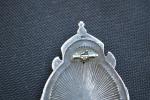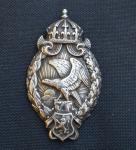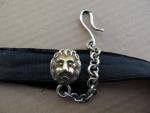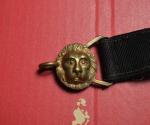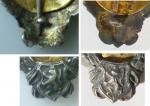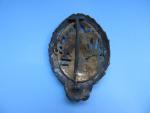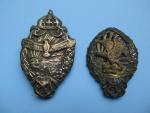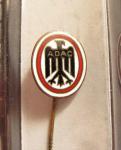-
Posts
1,149 -
Joined
-
Last visited
-
Days Won
1
Content Type
Profiles
Forums
Blogs
Gallery
Events
Store
Everything posted by Theodor
-
On the first photos, officers 1, 3 and 4 are not generals. Senior officers, probably colonels, but not generals. The collar tabs are for all officer ranks, but not the generals' oak leaves. The photo of 1 is pretty dark, but still I think he has the "ordinary" tabs, not general's. So, number 3 can not be Zhilkov, as that unknown man was not higher than a colonel in 1941, while Zhilkov was promoted to general back in 1937
-

My collection of Bulgarian cap badges, 1944-1991
Theodor replied to GC*'s topic in Central & Eastern European States
I am sorry, but the navy cockades are not my area, I can no date those -

My collection of Bulgarian cap badges, 1944-1991
Theodor replied to GC*'s topic in Central & Eastern European States
Nice collection! The red paint star on the last row is a common socialist type, not a rare or early. As for the green one with the hammer and sickle, is it Bulgarian at all? These were made in Bulgaria indeed, right after the war, by one of the royal times workshops for buttons, cockades, etc. But the production also included same color buttons with star with hammer and sickle and I have heard all these were made for the Soviet forces in Bulgaria, quite a significant army group which stayed in the country for a few years. -
Yes, they are. On the right is the Commader of the Air Force, col. Vasil Boidev. Behind him lt.col. Georgi Drenikov from the HQ of the AF, to the left... can't put a name for now, though have seen him on some photos. Is it dated? Probably pre-1940.
-

sword hangers ?
Theodor replied to blueman's topic in Great Britain: Militaria: Badges, Uniforms & Equipment
So, who was the first to use that style of belt and hangers? The Bulgarian ones were influenced from Russia. And not just Russia, the Germans had very similar. Probably some more countries, too? But who was the first? -

sword hangers ?
Theodor replied to blueman's topic in Great Britain: Militaria: Badges, Uniforms & Equipment
The Bulgarian ones were introduced in 1905 and used until the end of the WW2 -

sword hangers ?
Theodor replied to blueman's topic in Great Britain: Militaria: Badges, Uniforms & Equipment
Could be Bulgarian as well. Looks similar. Interesting, several countries had very similar navy belts -
-

Bulgaria Bulgaria - Commemorative Medal 1915-1918 War
Theodor replied to IrishGunner's topic in Central & Eastern European States
Медал за участие в Европейската война /Medal for participation in the European War/. In the award document it is mentioned as "...the commemorative medal..." -

Bulgaria Interwar Observer Badge
Theodor replied to Theodor's topic in Central & Eastern European States
Another similar one was seen recently, but I think it is fake. Too new, no sign of wear to the surface or any patina, just see those nice new prongs, holding the central piece to the wreath. Bad quality casting, just see the incomplere circle for the left prong on the back side and the rough surfaces. Another thing I don't like, the central piece has been not cast and then drilled, but cast the way it is, with the holes. I don't insist I am right, but I don't like it at all. And some indirect clues - comfortably poorly identified, comfortably low priced, with the option for even lower offer. Tried to compare with mine, it seems these two are different patterns, different in the small details. http://www.ebay.de/itm/Alter-Orden-evtl-Bulgarien-/251390778112?pt=Militaria&hash=item3a880edb00 -

Bulgaria Some photos of my little collection
Theodor replied to ruiz's topic in Central & Eastern European States
Very nice! And very good photos! -

Bulgaria Interwar Observer Badge
Theodor replied to Theodor's topic in Central & Eastern European States
This is the back side. The pilot badge is named and dated 1928, but I can say nothing for the observer badge. Just the period can be framed, from a couple of years after the end of WW1, until 1935-36. More likely 20s, being so extraordinary. But who knows! What they flew: right after the WW1, all Bulgarian Air Force aircraft were cut to pieces and the country had no right to have an air force at all. So in the next 15 or so years, it existed more or less secretly. The first aircraft was a WW1 Fokker, hidden in a village to evade being cut. It was fllowed by 2 machines, built from the cut pieces of WW1 planes. In 1924-26 were delivered not large numbers of Potez, Henriot, Cauldrone, Bristoll aircraft, also 2 Macci flying boats. Bulgaria could purchase only from the WW1 winners, only unarmed aircraft and with very limited engine power. In 1925 started the production of Bulgarian aircraft, various models, mostly training. Only in the 2nd half of the 1930's some modern aircraft were delivered and the number increased. In 1937 the Air Force, which existed anyway, was officially restored as a part of the Armed Forces and was given battle flags. -
Let me show the latest addition to the collection, an interwar Observer badge! The pilot badge is for comparison, it represents the usual construction, hollow silver. The Observer badge is very extraordinary, nearly one of a kind - 3 piece, cutout construction! And original nevertheless. Silver frame and gold plated brass center. The crown has been lost, but I like it anyway!
-

Bulgaria Bulgarian Badge information.
Theodor replied to ruiz's topic in Central & Eastern European States
Very difficult to tell. Not only the Bulgarian pilots got the pilot badge, but also a large number of Luftwaffe men. There are 2 types made - the first one is more common, the frame is stamped sheet metal, like on the scan above. The other type is more rare /but IMO not related to more value, just not so often seen/ - with flat back, the frame is thick and not seen as negative from the back, but thick, flat. Same for the Observer badge, two types. The paratrooper badge, based on the number of the trained paratroopers, probably 500 - 600 were made for the Bulgarian paratroopes, plus some more for Germans and other allies. However it is not impossible, that many more were made and never awarded. That's not unheard of with many types of badges and medals. -
Please feel free to use the photo, glad you like it!
-
The old pictures - these aren't soldiers, they are partisans, using army clothing. The stars are some self-made partisan insignia. The lion without crown, from the last link, is the current one! Introduced to the army in the 90's and used in this moment, too. I have never seen WW2 lion with removed crown.
-

Bulgaria Bulgarian help needed!
Theodor replied to Brigade-Piron's topic in Central & Eastern European States
The way I read it - Considering /examining/ epicrisis for the operations plan for the next week in the 53rd hospital 1953 year in the region of Teguon... Teguoch... not sure about the name. Epicrisis is in plural, operations is for surgery. -

Bulgaria Bulgarian Order for Bravery Soldiers Cross -Opinion
Theodor replied to Graf's topic in Central & Eastern European States
An officer's order which has lost all the enamels, maybe? -

Bulgaria Imperial Bulgarian belt buckle
Theodor replied to TeaRex's topic in Central & Eastern European States
I am afraid, yes. -
I was wondering about the age of that ADAC tinnie badge. During the TR, the ADAC ceased to exist, replaced by the DDAC /Der Deutsche Aitomobil Club/. I think that happened in 1934. The ADAC was restored only postwar. But the colors of the badge are kind of imperial, black-white-red, do not fit the post-WW2 period IMO. So what do you think, what is the age of that badge? Is it TR related, like made in 1933, before the DDAC times, or is it Imperial or Weimar era? Thanks!
-

Bulgaria Is this Bulgarian?
Theodor replied to francophile50's topic in Central & Eastern European States
The naval patch /or maybe cockade?/ is Bulgarian. But the "NCO patch" from the auction, I have never seen such thing before, I doubt it is Bulgarian. -

Bulgaria Bulgaria - Military Police Gorget
Theodor replied to Gordon Williamson's topic in Central & Eastern European States
The article that I have does not say anything about text, but I have seen WW2 period photos of a soldier with Bulgarian letters for V.P. on the armband. Just large, white color letters, probably painted. I will try to find the pictures. They are mine, but it will be a big luck to manage to find!



